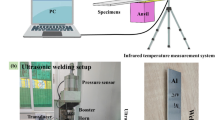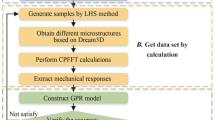Abstract
The grain structure deforms once a material is subjected to rolling and due to the same the properties get affected especially the thermal properties resulting in orthotropic thermo-physical property. So, for a high hardness material for example, Ti–6Al–4 V requires extensive study as these are exclusively used as replacement in human body like, implants. The study also ensures proper fitment and longevity. Now, since a considerable quantity of heat is generated while machining of these materials hence, to formulate the cooling strategy, deep understanding of the temperature – distribution becomes very essential. Moreover, it also controls the thermo–physical characteristics of the aforesaid hard materials. The present work numerically estimates the temperature distribution assuming 2D material domain. To achieve the objective, Finite Difference Scheme has been used using Python. The mathematical equations relevant to heat transfer along with relevant boundary conditions have been discretized and iterative method has been employed for the solution. The various thermo–physical properties have been explicitly depicted with the aid of 2D temperature distribution plots. The conclusion of the work can be employed for deciding the cooling strategies and also various machining parameters.
Graphical abstract






Similar content being viewed by others
References
Roy A.K, Kumar K (2019) Sustainability in bio-metallic orthopedic implants. biointerface Research in Applied Chemistry. 9 (1), 3825 – 3829. https://doi.org/10.33263/BRIAC91.825829
Markarian, R.A., Galles, D.P., França, F.M.G.: Dental implant-abutment fracture resistance and wear induced by single-unit screw-retained CAD components fabricated by four CAM methods after mechanical cycling. J. Prosthet. Dent. (2021). https://doi.org/10.1016/j.prosdent.2020.08.052
Mruthunjaya, M., Yogesha, K.B.: A review on conventional and thermal assisted machining of titanium based alloy. Mater. Today: Proceed. 46, 8466–8472 (2021). https://doi.org/10.1016/j.matpr.2021.03.490
Agrawal, C., Khanna, N., Gupta, M.K., Kaynak, Y.: Sustainability assessment of in-house developed environment-friendly hybrid techniques for turning Ti–6Al–4V. Sustain. Mater. Technol. 26, e00220 (2020). https://doi.org/10.1016/j.susmat.2020.e00220
Dhal, A.K., Panda, A., Kumar, R., Sahoo, A.K.: Different machining environments impact analysis for Ti-6Al-4V alloy (Grade 5) turning process: A scoping review. Mater. Today: Proceed. 44, 2342–2347 (2021). https://doi.org/10.1016/j.matpr.2020.12.432
Ma, Y., Du, Z., Cui, X., Cheng, J., Liu, G., Gong, T., Liu, H., Wang, X., Chen, Y.: Effect of cold rolling process on microstructure and mechanical properties of high strength β titanium alloy thin sheets. Progress in Nat. Sci: Mater Inter. 28(6), 711–717 (2018). https://doi.org/10.1016/j.pnsc.2018.10.004
Duan, X., Wang, M., Jia, D., Jing, N., Wu, Z., Yang, Z., Tian, Z., Wang, S., He, P., Wang, Y., Zhou, Y.: Anisotropic mechanical properties and fracture mechanisms of textured h-BN composite ceramics. Mater. Sci. Eng., A 607, 38–43 (2014). https://doi.org/10.1016/j.msea.2014.03.132
Kumar S,. Khan M.A. Muralidharan B. Processing of Titanium-Based Human Implant. Material using Wire EDM. Mater. Manuf. Process. 34(6), 695-700, (2019). DOI: https://doi.org/10.1080/10426914.2019.1566609
Liang, C., Zhao, J.F., Chang, J., Wang, H.P.: Microstructure evolution and nano-hardness modulation of rapidly solidified Ti–Al–Nb alloy. J. Alloy. Compd. 836, 155538 (2020). https://doi.org/10.1016/j.jallcom.2020.155538
Khanna, N., Shah, P., López de Lacalle, L.N., Rodríguez, A., Pereira, O.: In pursuit of sustainable cutting fluid strategy for machining Ti–6Al–4V using life cycle analysis. Sustain. Mater. Technol. 29, e00301 (2021). https://doi.org/10.1016/j.susmat.2021.e00301
Thirumaleshwar M, Fundamentals of Heat and Mass Transfer, 1st ed., Pearson Education India 2009.
Aghaee-Shalmani, Y., Hakimzadeh, H.: Numerical Modeling of 2-D and 3-D Flows using Artificial Compressibility Method and Collocated Mesh. J Appl. Fluid Mechanics 9(7), 2333–2345 (2016). https://doi.org/10.18869/acadpub.jafm.68.236.21800
Kara, S., Zhang, J.: Convergence and performance of iterative methods for solving variable coefficient convection-diffusion equation with a fourth-order compact difference scheme. Comput. Math. Appl. 44, 457–479 (2002). https://doi.org/10.1016/S0898-1221(02)00162-1
Mishra, T.N.: Analytical Solution of 2D Spl Heat Conduction Model. Int. j. latest res. 1(4), 47–54 (2015)
Shen, S., Dai, W., Cheng, J.: Fractional parabolic two-step model and its accurate numerical scheme for nanoscale heat conduction. J. Comput. Appl. Math. 375, 112812 (2020). https://doi.org/10.1016/j.cam.2020.112812
Iqbal, M., Stark, D., Gimperlein, H., Mohamed, M.S., Laghrouche, O.: Local adaptive. q -enrichments and generalized finite elements for transient heat diffusion problems. Comput.Methods Appl. Mech. Eng. 372, 113359 (2020). https://doi.org/10.1016/j.cma.2020.113359
Lewis, B. J., Nihan Onder, E., Prudil, Andrew A.: Difference numerical methods. In: Advanced Mathematics for Engineering Students, pp. 165–188. Elsevier (2022). https://doi.org/10.1016/B978-0-12-823681-9.00014-9
Wang, S., Ni, R.: Solving of two-dimensional unsteady-state heat-transfer inverse problem using finite difference method and model prediction control method. Complexity 2019, 1–12 (2019). https://doi.org/10.1155/2019/7432138
Kovtanyuk, A.E., Chebotarev, A.Y.: An Iterative Method for Solving a Complex Heat Transfer Problem. Appl. Math. Comput. 219(17), 9356–9362 (2013). https://doi.org/10.1016/j.amc.2013.03.091
Lam, T.T., Fong, E.: Application of solution structure theorem to non-fourier heat conduction problems: analytical approach. Int. J. Heat Mass Transf. 54(23–24), 4796–4806 (2011). https://doi.org/10.1016/j.ijheatmasstransfer.2011.06.028
Lam, T.T.: A unified solution of several heat conduction models. Int. J. Heat Mass Transf 56, 653–666 (2013). https://doi.org/10.1016/j.ijheatmasstransfer.2012.08.055
Woodbury, K.A., Najafi, H., Beck, J.V.: Exact analytical solution for 2-D transient heat conduction in a rectangle with partial heating on one edge. Int. J. Therm. Sci. 112, 250–262 (2017). https://doi.org/10.1016/j.ijthermalsci.2016.10.014
Koh Y.Y, Lim J.W.S and. Chua Y.L, Multigrid Solver for 2D Heat Conduction Problems. AIP Conference Proceedings. 2129, 020033 – 1 – 020033 – 6, (2019). https://doi.org/10.1063/1.5118041.
Nemirovsky, Y.V., Mozgova, A.S.: two-dimensional steady-state heat conduction problem for heat networks. J. Phys.: Conference Series 1359(1), 012138 (2019). https://doi.org/10.1088/1742-6596/1359/1/012138
Hu, Z., Liu, Z.: Heat Conduction Simulation of 2D Moving Heat Source Problems Using a Moving Mesh Method. Adv. Math. Phys. 6067854, 1–16 (2020). https://doi.org/10.1155/2020/6067854
Fong Ed, Yi S. Lam T.T Heating and Convective Cooling of Two-Dimensional Solids Using Diffusion and Cattaneo–Vernotte Models. J. Thermophys Heat Transf. 1–12, (2021). DOI: https://arc.aiaa.org/doi/pdf/https://doi.org/10.2514/1.T6255.
Udoye, N.E., Okolie, S.T.A., Fayomi, O.S.I., Banjo, S.O.: Computational analysis of conductive heat transfer in a rectangular slab of stable boundary using Monte Carlo method. IOP Confer Series: Mater. Sci. Eng. 1036(1), 012059 (2021). https://doi.org/10.1088/1757-899X/1036/1/012059
Adsul, P. P., Dineshkumar, L.: On code verification of 2D transient heat conduction in composite wall. IOP Conference Series: Mater. Sci. Eng. 377, 012128 (2018). https://doi.org/10.1088/1757-899X/377/1/012128
Roy, A Kumar, Kumar, Kaushik: 2D heat conduction on a flat plate with Ti6Al4V alloy under steady state conduction: A numerical analysis. Mater. Today: Proceedings 46, 896–902 (2021). https://doi.org/10.1016/j.matpr.2020.12.1152
Roy, A.K., Jeyapandiarajan, P., Kumar, K.: Numerical and Thermal Modelling of Machining Implants: A case with Ti6Al4V alloy with unsteady heat diffusion. Mater. Today: Proceed. (2021). https://doi.org/10.1016/j.matpr.2021.02.145
Bassam, A.: Abu-Hijleh, Numerical Solution of Periodic Heat Transfer in an Anisotropic Cylinder Subject to Asymmetric Temperature Distribution, Journal of King Saud University -. Eng. Sci. 9(2), 265–292 (1997). https://doi.org/10.1016/S1018-3639(18)30681-0
Atchonouglo K., Jean-Christophe Dupré, Germaneau A, Vallée C., Numerical identification of the thermal conductivity tensor and the heat capacity per unit volume of an anisotropic material. Mech. Industry, 20(6), 603, (2019). https://doi.org/10.1051/meca/2019026
Tahmasbi, V., Noori, S.: Multidimensional Numerical Analysis of the Thermal Behavior and Pyrolysis Gas Flow Inside an Orthotropic Porous Material. ASME. J. Heat Transfer. 142(6), 062701 (2020). https://doi.org/10.1115/1.4046890
Mishra, R.R., Kumar, R., Sahoo, A.K., Panda, A.: Machinability behaviour of biocompatible Ti–6Al–4V ELI titanium alloy under flood cooling environment. Materials Today: Proceedings. 23(3), 536–540 (2020). https://doi.org/10.1016/j.matpr.2019.05.402
Ranjan, A., Kumar, A., Roy, A.K., Kumar, K.: Python assisted numerical analysis of heat conduction for an orthotropic material. Advances in Materials and Processing Technologies. (2022). https://doi.org/10.1080/2374068X.2022.2031561
Özisik, M.N.: Heat Conduction, 2nd edn. Wiley, New York (1993)
Özişik M.N, Orlande H.R.B, Colaço M.J and. Cotta R.M, Finite Difference Methods in Heat Transfer, 2nd ed. CRC Press, 2017. DOI: https://doi.org/10.1201/9781315121475.
Sameti, Md., Fatemeh, R.A., Fathollah, P., Alibakhsh, K.: Analytical and FDM Solutions for Anisotropic Heat Conduction in an Orthotropic Rectangular. Am J. Num. Anal.. 2(2), 65–68 (2014)
Kreyszig E, Advanced Engineering Mathematics, 10th eds. John Wiley & Sons Inc, New York 2010
Acknowledgements
The authors sincerely acknowledge the comments and suggestions of the reviewer(s) and editor(s) that have been instrumental for improving and upgrading the paper in its final form.
Author information
Authors and Affiliations
Corresponding author
Additional information
Publisher's Note
Springer Nature remains neutral with regard to jurisdictional claims in published maps and institutional affiliations.
Rights and permissions
Springer Nature or its licensor holds exclusive rights to this article under a publishing agreement with the author(s) or other rightsholder(s); author self-archiving of the accepted manuscript version of this article is solely governed by the terms of such publishing agreement and applicable law.
About this article
Cite this article
Kumar, A., Roy, A.K. & Kumar, K. Heat conduction in an orthotropic material–numerical analysis using python. Int J Interact Des Manuf 17, 1089–1097 (2023). https://doi.org/10.1007/s12008-022-01051-4
Received:
Accepted:
Published:
Issue Date:
DOI: https://doi.org/10.1007/s12008-022-01051-4




